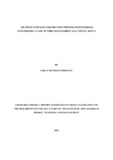| dc.description.abstract | Development projects in Kenya are proceeding at an increasingly rapid pace as a strategy
towards achieving vision 2030. Large scale projects can bring significant benefits to
communities as construction of roads, health, educational facilities, creation of jobs and other
economic opportunities. However, Dam construction projects have already affected the natural
and social environments around them and threaten to cause further devastation for local
livelihoods as the projects increase in size and number. The Thiba Dam is located in Rukenya,
Gichugu constituency of Kirinyaga County in Kenya. The purpose of the dam was developed to
improve irrigation facilities in order to improve rice crop production and also provide a stable
supply of water required by agriculture in the Irrigation scheme. This study therefore
investigated the influence of dam construction projects on household livelihood, a case of Thiba
dam Kirinyaga County, Kenya. The study focused on the effects of; land acquisition by dam
construction project, Social disruptions by dam construction project, provision of social
amenities by dam construction project and compensation offered by dam construction project on
the households’ livelihood. The findings of this study will be significant to the government of
Kenya in proving empirical information on the influence of Dam construction projects on the
livelihood of households around the dam. The findings will help in the estimation of
compensation for the PAPs. Further the findings will help the implementers as well as the donors
to estimate the benefit of the projects against the costs incurred. Finally the findings of this study
will be significant to future researchers in finding literature on dam construction and household
livelihoods. This study will also act as a stepping stone to further research. The study employed a
descriptive research design. The target population under study was 845 households that have
been displaced by the construction of Thiba Dam however the study only sampled 271 PAPs by
use of stratified random sampling. Data was collected by use of questionnaires. The data was
analysed quantitatively and qualitatively and presented using frequencies, regression analysis.
Statistical Package for Social Sciences (SPSS) version 21 aided in generating a summary of
results which were represented in form of tables. The study found out that 51.3% of household
livelihood can be explained by acquisition of land belonging to households living around the
dam. The findings also showed that only 15.3% of household livelihoods can be explained by
compensation offered to households by the dam constructors, while only 1.4% of the household
livelihoods can be explained by social amenities provided by the implementers of Thiba dam
construction project and finally 36.4% of household livelihood can be explained by social
disruption caused by Thiba dam construction. | en_US |

